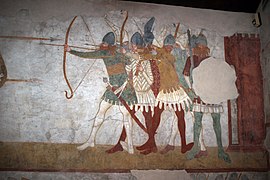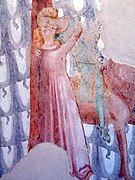Castello di Avio
| Castello di Avio | ||
|---|---|---|
| Alternative name (s): | Castello di Sabbionara | |
| Creation time : | 11th century | |
| Conservation status: | ruin | |
| Construction: | Quarry stone | |
| Place: | Sabbionara d'Avio | |
| Geographical location | 45 ° 44 '47 " N , 10 ° 57' 7.2" E | |
| Height: | 300 m slm | |
|
|
||
The Castello di Avio or Castello di Sabbionara (also called "Aue Castle" in old German texts) - partly from the 11th century - is one of the oldest fortifications in Trentino . It is located above the Vallagarina ( German Lagertal ) in the municipality of Avio (district Sabbionara d'Avio). The castle has been owned by the Fondo Ambiente Italiano (FAI) Foundation since 1977 thanks to a donation from Countess Emanuela di Castelbarco .
history
Sabbionara d'Avio owes its geopolitical strategic importance to its geographical position: at the back, the hill of Sabbionara d'Avio is protected by the mountains, while at the same time it overlooks the historically important fords of the Adige River in the valley. The Vallagarina, over which the castle towers, was one of the main connecting routes between Northern Europe and the Mediterranean, between the Po plain and the Germanic empire. The ancient Via Claudia Augusta , which was built in 15 BC , led through them . Was built and the course of the modern north-south connections follow.
The first historical sources mentioning the fortification called Castellum Ava in Sabbionara d'Avio date back to 1053. In the 12th century the castle belonged to the Castelbarco family, vassals of the Bishop of Trento . They left the castle to the Venetians by will in 1411 . They expanded the castle complex with a chapel in honor of St. Michael and decorated the facade with the coat of arms of their doges . In 1509, after the defeat of Venice in the Battle of Agnadello and the retreat of the Serenissima from southern Trentino , the castle fell into the hands of the Habsburg troops under Emperor Maximilian I , who had the imperial coat of arms painted on it and the castle then mortgaged the Count of Arco left. Further changes of ownership followed until the castle came back into the possession of the Castelbarco family in the 17th century. In 1977 Emanuela Castelbarco, Arturo Toscanini's granddaughter , donated the castle to the FAI, who restored it and then opened it to the public.
description
The castle consists of three wall rings, which encircle the entire defense system in a wreath. It has five towers, including the picadora tower , where in the past the death penalty was carried out by hanging . Its boundary line follows the sloping terrain and is therefore uneven. To the mighty keep in the 11th century around there are several with frescoes decorated building such. B. the guardhouse, the chapel, the baron's palace and the love room on the top floor of the keep itself. The cycle of frescoes in the love room is attributed to an artist from the Venetian-Emilian environment who lived in the 14th century and whose work was already in the Dominican church can be seen in Bolzano . The frescoes in the guard house, on the other hand, which have the art of war and knighthood as their theme, go back to an artist from Trentino from the second half of the 14th century, who combines the style of Verona with stylistic elements of the northern Alps.
bibliography
in alphabetical order by authors / editors
- L. Borromeo Dina (Ed.): Castello di Sabbionara d'Avio , Milan 2005.
- L. Borromeo Dina (Ed.): Il libro del FAI , Milan 2005, pp. 17-37.
- G. Ulrich Großmann: The Castello die Avio near Sabbionara . In: INSITU 2018/1. ISSN 1866-959X, pp. 37-50.
- Sabine Sommerer: The Camera d'Amore in Avio. Perception and effect of secular wall painting of the Trecento. Chronos, Zurich 2012, ISBN 978-3-0340-1021-4
Web links
- www.fondoambiente.it - Castello di Avio (in Italian)






